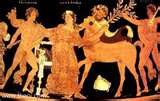The Centaurs disrupting the Lapith wedding feast is a story depicting the Centaurs as strange hybrids of human and horse, man and beast, with the Centaurs having equine ears and lower torsos.
Satyrs however are also depicted as having horse tails and ears.
The idea that Satyrs are part goat dates to the Roman era.
The Romans seem to have thought Satyrs and Fauns were the same.
So what underlies these images.
Animal features as symbols of lust?
Depictions of nature spirits possessing male cultists during Dionysiac rituals?
Old stories about mountain tribes so primitive they wore fur rather than wool ?
Perhaps a sly dig at randy aristocrats behaviour during parties since horse ownership was a luxury for the wealthy?
Given the antiquity of these myths perhaps all the explanations are equally valid?
Bear in mind when you're looking at art featuring myths that the original artist's intentions may differ from your interpretations.













